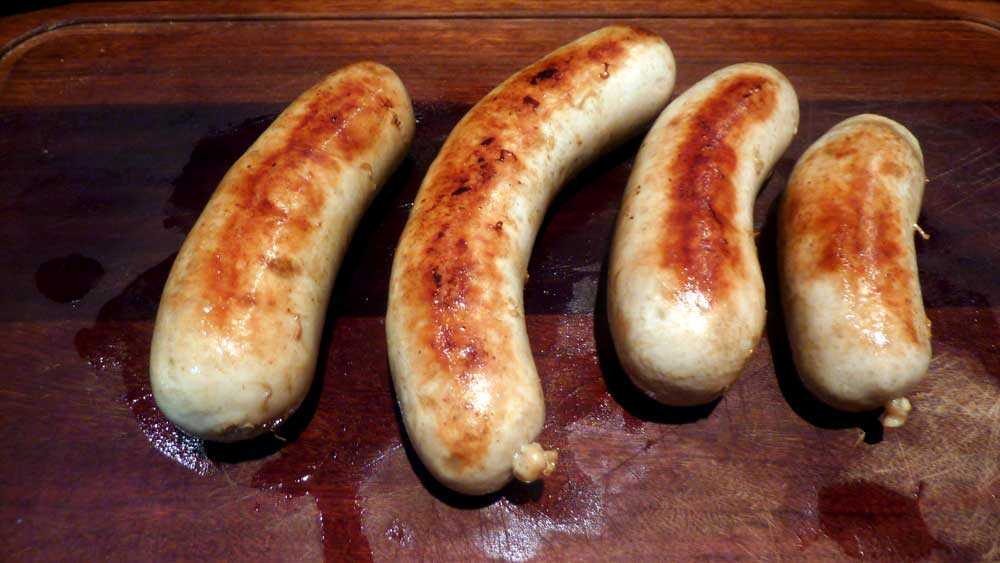
German sausages are famous for their excellent production and diversity of recipes. Bratwurst sausage is a type of German sausage made from veal, beef and/or pork. The name comes in German from Brätwurst, brät (finely cut) and Wurst (sausage), although currently the understanding also refers to the verb braten, which means fried or roasted.
It is important to read this introductory text before starting the recipe because the secret of the sausage lies in the details of the process and not in the recipe! Without reading and re-reading the process, preferably from different sources, trying, making mistakes and persevering, it is unlikely anyone will make a good sausage.
Making sausage at home is an often frustrating challenge, especially at the beginning, firstly due to the need for some control over temperatures during production, secondly because it requires power from the food processor used and thirdly due to the difficulty of incorporating the emulsified dough. which is much softer than a sausage. A meat grinder is not necessary, as you can leave all the work to the processor, but grinding can make processing easier. In this case I didn't use a grinder, I just chopped the meat and put it in the processor, which, despite the heat generated, proved heroic in carrying out the task. Important detail: the processor's cutting blades must be very sharp!
All sausage is what is commonly called a meat emulsion or, in more detail, a uniform, stabilized mixture of water, fat and protein. The stability of this mixture depends on a good source of protein and low temperature. Powdered milk also helps stabilize the dough. If the temperature rises during preparation, the fat will melt and the emulsion will come apart. The fat used must be firm, rigid, preferably from the porcine subcutaneous region, such as the belly, shank or jowls. Leather/skin can also be used, as it is a great “binder”, but I did not use it as the meat was of high quality, requiring no skin or additional additives. Industrial sausages use a lot of skin, stabilizing and emulsifying additives as they overuse water and CMS (“Mechanically Separated “Meat”), which is a poor source of protein. To learn more about Brazilian legislation on sausages, see the post What is sausage made of?
Using domestic equipment it is very difficult to achieve a completely smooth dough, without grains, but with reasonable equipment and a dose of patience it is possible to get close to it. Don't be afraid to stop the process, cool the dough again and continue processing later. The biggest difficulty is the temperature, as domestic processors heat the sausage dough a lot, which is dense and requires a lot of equipment. If you don't have good equipment, I suggest you do the homemade chicken sausage, which requires less equipment. In industry, the cutter or colloidal mill is used. Both are very efficient in transforming everything into a smooth dough.
Below is an image of an open cutter with the blades exposed and a video showing the texture and final density of the carnea emulsion. Ideally, the dough should look like the one in this video.

More traditional recipes usually use between 20% and 30% of fat in the product, that is, for 800g of meat they add approximately 200g of additional fat. I used a lot less than that, but the more fat you use, the more delicate and tender the sausage will be. Too little fat tends to create a denser, drier product. The recipe I made is quite simple and is a natural sausage, no additives, No preservatives It is no dyes.
The ham I purchased weighed 2150 grams and after removing the bone, skin and external fat, it weighed 1140 grams. I discarded the skin and used the fat.
Ingredients for natural homemade Bratwurst sausage
Clean shank – 1140 g
Fat – 238 g
Salt – 18g
Powdered milk – 15g
Sugar – 15g
White pepper – 2g
Hot paprika – 1g
Homemade vegetable broth – 200g
Pork tripe* - 2 m
*The casing can have the desired caliber and be natural or collagen. As I wanted to fry and eat with the tripe, I opted for medium-sized natural pork. Bratwurst is made to be fried, so the best option for me is, by far, natural pork or sheep intestine.
Below is a percentage reference table to facilitate the production of different quantities
| Ingredient | weight(g) | % |
| Ham | 1140 | 73 |
| Fat | 238 | 15 |
| Homemade vegetable broth | 200 | 12 |
| Total | 1578 | 100 |
If your ham does not have enough fat, you can purchase a piece of pork belly (bacon) and add it.
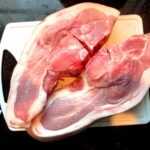
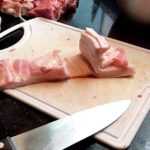
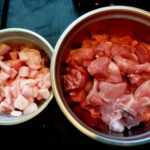
Preparation of homemade natural Bratwurst sausage
Always keep everything cold, dishes, equipment, meat, fat and liquids added to the recipe must all be very cold. The chopped fat may be frozen. Leave everything in the freezer before using. Constantly measure the temperature of the dough and always try to keep it below 15 degrees.
Grind and make carnea emulsion
- Chop the meat with a knife, take the opportunity to remove the nerves;
- Chop the fat, reserve and freeze;
- Leave the vegetable broth very cold or freeze it and chop it very finely, like crushed ice;
- Optional: Pass the meat through the grinder with the wide disc and place in the freezer for a few minutes to cool again;
- Place the meat in the food processor fitted with the cutting knife and start processing on high power;
- Add all dry ingredients;
- Add the frozen fat and continue processing;
- Gradually add the well-chilled or frozen and chopped broth. It is important to add it little by little to cool the dough during processing;
- Measure the temperature constantly and if it exceeds 15 degrees, take it immediately to the freezer and wait a few minutes for the temperature of the dough to reduce;
- Continue processing until the mixture is smooth, homogeneous, with the appearance and consistency of a paste, like toothpaste, the smoother the better;
- If the consistency of the dough is too dense, add more liquid, which can be very cold water or crushed ice. Watch the description video to see the correct texture.
Insert and cook the sausage
- Fill the casing with the dough, roll it up or tie it with string every 10 or 15 centimeters.
- Cook in water heated to 75 degrees for about 20 minutes.
- Fry on a griddle or frying pan with a little oil.
I made a short video that shows the cleaning of the meat, separation of the leather and fat and the beginning of processing. I didn't film the rest because I had to stop to cool down and forgot to continue filming... our fault! Next time I'll do it completely.
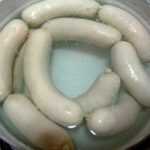
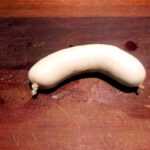
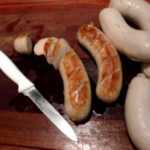






Two questions: 1) If I maintain this proportion, can I make a smaller quantity? 2) can I freeze it? If so, after cooking?
Yes, just keep the proportion to make a larger or smaller quantity. So, cook it and then freeze it well packaged, preferably in a vacuum. It will last at least 3 months this way.
Good morning. What vegetables are used in vegetable broth?
Onion, garlic, carrot, celery/celery, parsley and chives.
I would like to buy homemade sausage, without preservatives or colorings and ready-made. Can you recommend someone in São Paulo, SP?
Hi Felipe, I don't know of anyone who produces this way in SP. For commercialization, the use of curing salt is mandatory, you would have to try an artisanal producer who agrees to do it this way.
Good afternoon, my question is regarding the visual aspect (color). How do I make the sausage red and not white?
Just like the ones on the blog
https://charcutaria.org/embutidos/como-fazer-salsicha/
Hi Julio, curing salt and carmine dye to make it red. If you want it more orange, you have to use liquid annatto coloring.
Annatto powder
Good morning Rodrigo.
Thanks for the recipe, a doubt if I make it in a grinder. What disc number do you recommend for grinding the second time?
We are going to produce an Oktoberfest, a friend already has the beer ready. Hahahaha
Hi Orlando, grind twice on the smallest disc possible. Then mix well until you obtain a homogeneous dough.
Good morning Eduardo. Thanks for the excellent website. Can I make brattwurst just with the meat grinder, without using the processor?
Hello Rodrigo. I've done several tests and the texture isn't the same, it's a little more grainy, but it's close. Grind the well-chilled (almost frozen) meat twice on the finest grinder disc you have, mix well to create a good blend and you can embed it. If you have it, add isolated soy protein or a income mix to help with the emulsion.
Hello ! Would a cutter like this be suitable for a small production with good emulsification?
Model
Skymsen cr 4l
Thank you 🙂
Hi Fábio, I've never tested this cutter but apparently, given its characteristics, it has everything it takes to generate a good emulsion. Ask the manufacturer about this specific use, they may have some tips. In general, follow the low temperature standards, add a good amount of crushed ice and use an emulsifier/yield mix. Salt the meat a day in advance. Grind once or twice and only then process with the cutter. This will help a lot in the success of the emulsion.
200 gr of broth……I didn’t understand the measurement
I was wrong, if you're going to use salt it should be curing salt 1. Right?
Hi Magno. That's right, it's best to use curing salt 1. It will last longer, prevent rancidity and give it a typical cured flavor. Use curing salt 1 in conjunction with a sodium erythorbate-based antioxidant. Erythorbate is a healing accelerating antioxidant, that is, it increases the speed of the reaction/conversion of sodium nitrite. Using the recommended minimum curing salt, which is 2.4g per kg of meat for instacure#1 standard curing salt, will likely have zero residual nitrite in the final product. Some antioxidant mixes already come with an acidifier, so the wine does not need to be acidified.
Let's try to improve. Thank you, abs
Hello. I'm planning to make this sausage for the 2nd time. The emulsion is working properly and the flavor is more intense, as I wanted, but I would like to increase the shelf life. I ate one that had been in the fridge for 5 days and I thought it had a different flavor. I ask: is it worth using a little cure 2, or maybe just white wine to make it more acidic? Thank you
Hello Magno, how are you?
How cool that you got the flavor right! It's a joy to get rid of commercial sausages, right?
If I understand your question well, the answer is no. The #2 curing salt (sodium nitrate) is only used for long-curing products (more than 30 days). As the sausage is cooked/fried/passed through some cooking method, the sodium nitrate usually releases nitrosamine which is harmful to our body. So, if you want to increase the shelf life of the product and obtain the color and flavor characteristic of cured products, use only nitrite (curing salt #1) for your sausage.
Hugs
Good morning! 😀
Sorry for my ignorance. I would like to know how I should store the sausage after bagging it. Should I cook and store in the refrigerator or store without cooking?
Hi Rafael, cook it first and then refrigerate or freeze it.
YOUR TABLE IS WRONG. 238 GR OF FATS EQUIVALS TO 20.87% AND NOT 15% AS DESCRIBED.
Hello, Maercio. The proportion is calculated based on the total weight of the dough, including the liquid. In this way, 238g(of fat) of 1578g(total weight) = 15.08% of the total weight of the product. Without the liquid it would be 238g(of fat) of (1378 meat+fat) = 17.27%.
Excellent recipe, I made it and it looked great. However, it lost a lot of flavor, I think during cooking. Does anyone have any suggestions?
Hi Magno, I'm glad it worked! It is a recipe with a simple and mild seasoning, you can increase the spices with, for example, some herbs, garlic and nutmeg. This will greatly enhance the flavor. Finish by browning it in the pan with butter and olive oil, which also enhances the flavor and improves the final appearance. Hugs!
Noble Schulze,
1) Total amateurism of the charcuterie freshman: I tried to process the dough in a home blender and almost burned it; later, I used a mixer and also stayed almost (uniform the dough).
2) Embed it in the casing of the sausage, in large units (attached image);
3) I followed the recipe to the letter, but I thought it was extremely spicy and the flavor was nothing like what we are used to buying. It didn't crumble and the casing didn't break;
4) Despite the work and the lack of success, I enjoyed the game!
Hi Eduardo. Thanks for the feedback, I'm glad to know that overall it worked. It's complicated in a blender, the dough is very dense and the blender has no power, only speed. The ideal is a good food processor. It is possible with a mixer and the ideal in this case is to grind twice on a fine disc and beat the dough well afterwards. Homemade sausage is a great challenge! This recipe is very different from the industrial ones, it is more reminiscent of German white sausage. It's a very simple base recipe, perhaps you found the pepper strong. I like to finish it in the pan with olive oil, the tripe turns golden brown. A big hug!
Teacher,
He said it all: IT REMINDS ME MORE OF GERMAN WHITE SAUSAGE...
Thanks again!
Goodnight!!!
I'm starting to produce sausages, but I'm interested in producing sausages too, I know I'll need a battery, so which mixer or processor do you recommend I buy?
Good evening, if you only use beef, what part would be
recommended
You can use any part, the important thing is to balance the amount of protein and fat, always add between 20% and 30% of rigid fat, which can be of bovine and/or pork origin. Beef will make the sausage darker and have a stronger flavor.
Friend, forgive my ignorance, but what would be the ideal casing to use so that the homemade sausage has a similar diameter to the purchased sausage?
Hi Jader, this German bratwurst sausage in the recipe is thicker, it was made with 32mm casing. Smaller supermarket sausages, like hotdogs, generally use much thinner casings, measuring 19mm to 22mm.
Good morning. How do you get the white color of German sausages? Could it be the added milk? Both pork and veal are not white. Thanks.
The powdered milk does not interfere with the coloring, it only helps to create a good emulsion, which is very difficult with homemade equipment. From what I know, Weisswursts don't just have veal, they have proportions of pork, veal, fat and some also have poultry meat. It depends on the region, tradition and recipe. There are no added dyes, curing agents and color fixers. In this recipe, for example, I only used ham and the sausage was very light, if I added chopped parsley it would be like German weisswurst.
Congratulations on the publications, an easy and very objective read, excellent tips for those who like to prepare their own sausages, especially without using chemical additives and using homemade equipment.